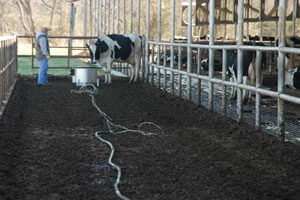“We have a lack of information in climate change – or climate variability – when it comes to animal agriculture,” Mukhtar said. “And we do not have the Extension outreach education capacity in the U.S. to address climate-change issues in animal agriculture.”
In addition to the direct effect of atmospheric climate change on animal agriculture, there’s the regulatory atmosphere to consider, he said.
“Currently, greenhouse gas-emission reporting is not enforced by the EPA for animal agriculture, but that may not be the case in the future,” Mukhtar said.
It’s commonly known that ruminant animals produce methane and other gases during digestion, but more work is needed to estimate how much of these gases, as well as waste water, is produced under varying management and climatic conditions, he said.
“In Texas, we have a little better advantage on the Texas AgriLife Research side, of which I’m also a part. The researchers at the Center for Agricultural Air Quality Engineering and Science have been measuring greenhouse gas emissions from dairy and beef cattle operations,” he said. “So we have some estimates of how much nitrous oxide, methane and carbon dioxide are produced by animal agriculture in southwestern climate and management systems.”
The grant will enable AgriLife Extension and extension personnel in several universities in the Southwest and other regions to come together and “chalk out a plan,” Mukhtar said.
“First we need to learn ourselves what is available in terms of information and education,” he said.
Mukhtar said he and his colleagues will spend “ample time” sifting through what research-based information is available relevant to animal feeding operations and climate change.
Animal agriculture, has been identified as a relatively minor source – 1 to 3 percent – of total U.S. greenhouse gas emissions, Mukhtar noted.
“But this grant will enable AgriLife Extension, after an accounting and sharing of research results, to come up with suggestions of ways to reduce emissions from animal feeding operations,” he said. “Once we have that information base built for the southwestern region, then we will start building educational materials, webinars, lesson modules, and such that we can bring to the extension personnel and technical service providers, commodity groups and general public.”
AgriLife Extension’s share of the grant will be about $670,000. Eventually, the goal is to share information not just at the state and regional levels, but nationally as well, Mukhtar said.
The other land-grant university extension agencies sharing the grant are the University of Nebraska, Washington State University, the University of Georgia, Cornell University and the University of Minnesota. ![]()
—From AgriLife Extension news release
PHOTO:
A Texas AgriLife Extension Service student worker monitors equipment specifically engineered to take real-time measurements of greenhouse gases – methane, nitrous oxide and carbon dioxide – in a dairy barn manure alley.
Photo courtesy of Texas AgriLife Extension Service.
I don’t know what I’m talking about
July 25, 2024







